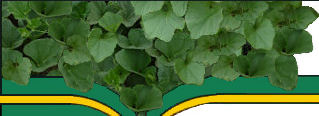
|
|
Growing Gourds |
|  Gourd seeds Gourd seeds
|
| In
the beginning, I only grew birdhouse or bottle gourds from seeds
purchased at a grocery store. After that first crop.I ran across
some old copies of the American Gourd Society's journal, "The
Gourd" and became aware that there are many types of gourds.
Since then I have purchased seeds for long-necked dipper, basketball,
cannonball, kettle,... all sorts of gourds.
Frequently I am asked if I use my own gourd
seeds to grow next year's crop. I have tried to use the seeds from
my gourds, but without much luck. Cross pollination often results
in some strange shapes and a significant percentage of my home grown
seeds don't germinate. Many vendors sell good quality gourd seeds
at reasonable prices, so I purchase seeds through the mail. Most
of these seeds germinate, though there is always a percentage that
fail. It is disheartening to plant and water seeds, hover over the
mound and carefully pull weeds, only to have nothing grow.
The quality of mail order gourd seeds depends
on the grower, of course, and how meticulous they are when gathering
and labeling the seeds. Sometimes I'll plant what I believe will
grow into cannonball gourds only to get round gourds with a short
neck. However, most of the time I can make use of whatever I grow.
|
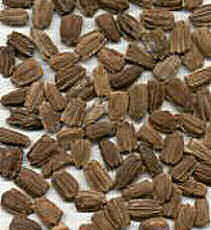 |
| |
|  Pollination Pollination
|
Because I had almost
three acres of available ground, I took care to plant different
gourd types some distance from each other to thwart cross pollination.
But this happened anyway. In the fall, I would find some strangely-shaped
gourds that seemed unusable. Since hard shell gourd plants bloom
at night, large moths are the main pollinators. Those hard working
moths still flew from plant to plant, garden to garden.
To minimize the chance of cross pollinization,
I have tried hand pollinization. One way to do this is to detach
a male blossom and move it around from female blossom to female
blossom and , hopefully, knocking off some pollen onto the females.
No formal introduction is required for this procedure.
Although this process reduces cross-pollinization,
it doesn't completely stop Mother Nature. Each fall I still find
a few grouds that are obvious mixed breeds. |
 |
| |
 Growing
gourds on a trellis Growing
gourds on a trellis |
Eventually, I built several trellises
for growing many of my gourds. These wood and wire structures work
great for snake and dipper gourds, as well as bottle and canteen
gourds. I built each trellis high, but sometimes not high enough.
I have even dug holes in the ground to accommodate some of my long-necked
gourds. (When snake and dipper grouds rest on the ground, they tend
to curl, and I didn't want that.)
In the photo on the right, these snake gourds
became so long and heavy that I built wooden planks to help support
them and keep them off of the ground.
|
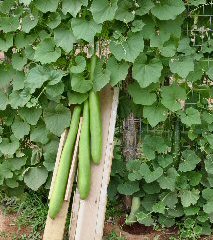 |
| |
|  Harvesting Harvesting
|
I plant seeds sometime after the
last frost in the spring, and I harvest the gourds after the first
hard frost in the fall. Each year I harvest between 200 to 400 gourds.
After the first frost in the fall, the luscious gourd plant leaves
wither. In a few days, the leaves and vines turn black. Only after
the frost do I finally know exactly how many gourds I will harvest.
Notice the soda can I placed on the bottom right
of this photo. I use the can to demonstrate the size of these gourds,
many of which weigh over 60 pounds. I made a special cart for moving
these big gourds. Smaller ones I can pile into a wheelbarrow.
Some people leave their gourds on the ground
all winter, while others move the gourds to pallets or sheds. Either
way, it takes them all winter to dry. For reasons unknown to me,
a few gourds just shrivel up during the drying process. |
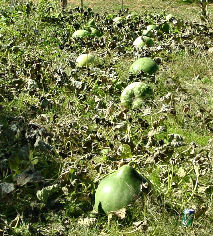 |
| |
|  Growing
gourds in the desert Growing
gourds in the desert
|
I live
just south of Moab, Utah, where the land looks much like this photo
- dry desert with lots of red sand. You might think not much would
grow here, but gourds seem to thrive. The average annual precipitation
here is 8.9 inches.
After I plant the seeds, I only water the area
a few times a week, depending on whether we get any rain. But after
the leaves grow fairly large, I need to water the plants constantly.
To eliminate the need to stand by my plants 24 hours a day with
a hose, I built drip systems for each of my gourd trellises and
flat plots.. If I turn off the drip system in the heat of the summer,
the plants wilt in 24 hours.
Normally, we don't get much rain in southern
Utah, but since 2004 marked the seventh year of a drought in this
area, we have been getting less than usual. As long as the drought
continues, growing anything here will continue to require lots of
irrigation. |
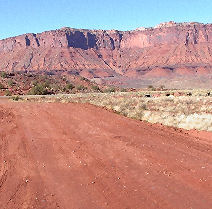 |
| |
|  Thumbnails
(Note: Click any photo to see the larger
version - then click the browser Back button to return to this page.) Thumbnails
(Note: Click any photo to see the larger
version - then click the browser Back button to return to this page.)
|
|
|
|
Copyright
© 2005-2006 by R E Ridges | Grand Gourds | Ann Gordon, Webmaster
|
|
